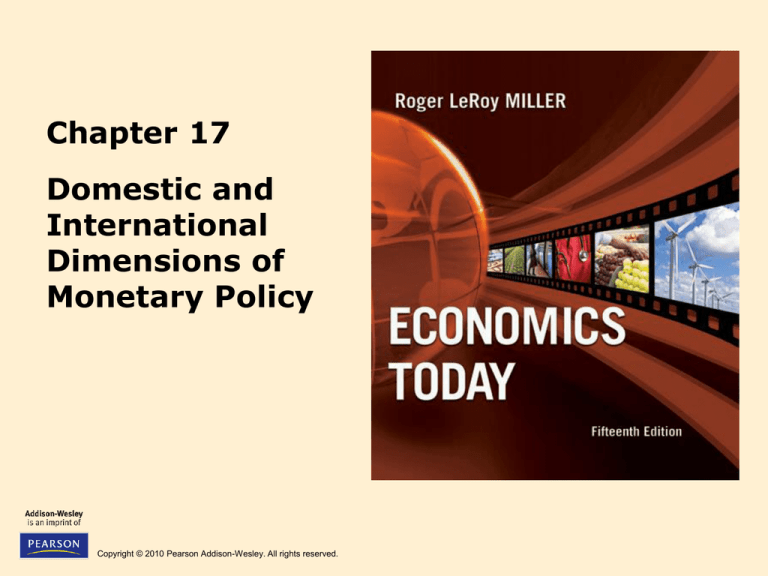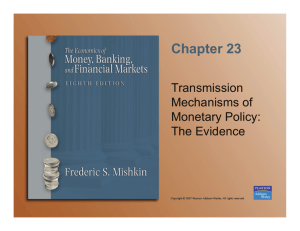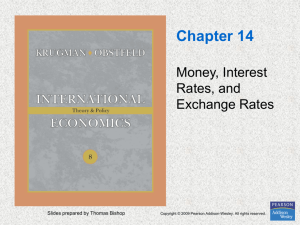
Chapter 17
Domestic and
International
Dimensions of
Monetary Policy
Copyright © 2010 Pearson Addison-Wesley. All rights reserved.
Effects of an Increase in The
Money Supply
• What if hundreds of millions of dollars in
just-printed bills is dropped from a
helicopter?
• People pick up the money and put it in their
pockets, but how do they dispose of the
new money?
17-2
Copyright © 2010 Pearson Addison-Wesley. All rights reserved.
Effects of an Increase in The
Money Supply (cont'd)
• Direct effect
– Aggregate demand rises because with an
increase in the money supply, at any given price
level people now want to purchase more output
of real goods and services.
17-3
Copyright © 2010 Pearson Addison-Wesley. All rights reserved.
Effects of an Increase in The
Money Supply (cont'd)
• Indirect effect
– Not everybody will necessarily spend the
newfound money on goods and services.
– Some of the money gets deposited, so banks
have higher reserves (and they lend the excess
out).
17-4
Copyright © 2010 Pearson Addison-Wesley. All rights reserved.
Effects of an Increase in The
Money Supply (cont'd)
• Indirect effect
– Banks lower rates to induce borrowing.
• Businesses engage in investment.
• Individuals consume durable goods (like housing and
autos).
– Increased loans generate an increase in
aggregate demand.
• More people are involved in more spending (even those
who didn’t get money from the helicopter!).
17-5
Copyright © 2010 Pearson Addison-Wesley. All rights reserved.
Effects of an Increase in The
Money Supply (cont'd)
Graphing the Effects of an Expansionary
Monetary Policy
• Assume the economy is operating at less
than full employment
– Expansionary monetary policy can close the
recessionary gap.
– Direct and indirect effects cause the aggregate
demand curve to shift outward.
17-6
Copyright © 2010 Pearson Addison-Wesley. All rights reserved.
Figure 17-1 Expansionary Monetary
Policy with Underutilized Resources
• The recessionary gap is
due to insufficient AD
• To increase AD,
use expansionary
monetary policy
• AD increases and
real GDP increases
to full employment
17-7
Copyright © 2010 Pearson Addison-Wesley. All rights reserved.
Effects of an Increase in The
Money Supply (cont'd)
Graphing the Effects of Contractionary
Monetary Policy
• Assume there is an inflationary gap
– Contractionary monetary policy can eliminate
this inflationary gap.
– Direct and indirect effects cause the aggregate
demand curve to shift inward.
17-8
Copyright © 2010 Pearson Addison-Wesley. All rights reserved.
Figure 17-2 Contractionary Monetary
Policy with Overutilized Resources
• The inflationary gap is shown
• To decrease AD, use
contractionary monetary policy
• AD decreases and real
GDP decreases
17-9
Copyright © 2010 Pearson Addison-Wesley. All rights reserved.
Open Economy Transmission of
Monetary Policy
• So far we have discussed monetary policy in
a closed economy.
• When we move to an open economy,
monetary policy becomes more complex.
17-10
Copyright © 2010 Pearson Addison-Wesley. All rights reserved.
Open Economy Transmission of
Monetary Policy (cont'd)
• The net export effect of contractionary
monetary policy
• Boosts the market interest rate
• Higher rates attract foreign investment
• International price of dollar rises
• Appreciation of dollar reduces net exports
• Negative net export effect
17-11
Copyright © 2010 Pearson Addison-Wesley. All rights reserved.
Open Economy Transmission of
Monetary Policy (cont'd)
• The net export effect of expansionary
monetary policy
• Lower interest rates
• Financial capital flows out of the United States
• Demand for dollars will decrease
• International price of dollar goes down
• Foreign goods look more expensive in United States
• Net exports increase (imports fall)
17-12
Copyright © 2010 Pearson Addison-Wesley. All rights reserved.
Monetary Policy in Action: The
Transmission Mechanism
• Recall we talked about the direct and
indirect effects of monetary policy
– Direct effect: implies increase in money supply
causes people to have excess money balances.
– Indirect effect: occurs as people purchase
interest-bearing assets, causing the price of such
assets to go up.
17-13
Copyright © 2010 Pearson Addison-Wesley. All rights reserved.
Figure 17-4 The Interest-Rate-Based
Money Transmission Mechanism
17-14
Copyright © 2010 Pearson Addison-Wesley. All rights reserved.
Figure 17-5 Adding Monetary Policy to the
Aggregate Demand–Aggregate Supply Model,
Panel (a and b)
At lower rates, a larger
quantity of money will
be demanded
The decrease in the interest
rate stimulates investment
17-15
Copyright © 2010 Pearson Addison-Wesley. All rights reserved.
Figure 17-5 Adding Monetary Policy to the
Aggregate Demand–Aggregate Supply Model,
Panel (c)
The increase in investment
shifts the AD curve to the right
17-16
Copyright © 2010 Pearson Addison-Wesley. All rights reserved.










